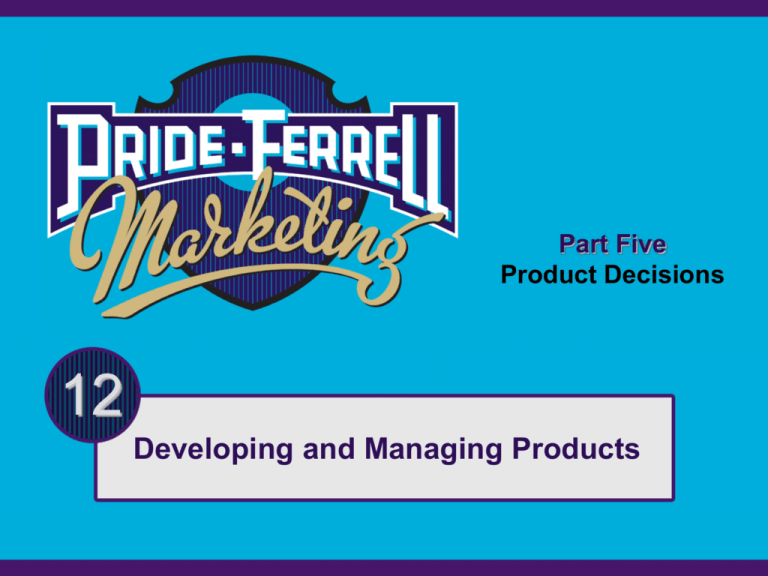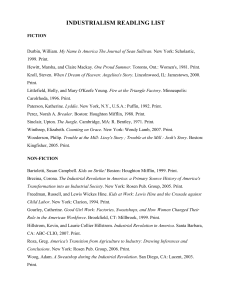
Part Five
Product Decisions
12
Developing and Managing Products
Objectives
1. To understand how companies
manage existing products through line
extensions and product modifications
2. To describe how businesses develop a
product idea into a commercial product
3. To understand the importance of
product differentiation and the
elements that differentiate one product
from another
Copyright © Houghton Mifflin Company. All rights reserved.
12 | 2
Objectives (cont’d)
4. To explore how products are
positioned and repositioned in the
customer’s mind
5. To understand how product deletion is
used to improve product mixes
6. To describe organizational structures
used for managing products
Copyright © Houghton Mifflin Company. All rights reserved.
12 | 3
Chapter Outline
• Managing Existing Products
• Developing New Products
• Product Differentiation Through Quality,
Design, and Support Services
• Product Positioning and Repositioning
• Product Deletion
• Organizing to Develop and Manage
Products
Copyright © Houghton Mifflin Company. All rights reserved.
12 | 4
Managing Existing Products
• Line Extension
– Development of a product that is closely related to
existing products in the line but meets different
customer needs
• Is a less expensive, low-risk
alternative
• May focus on the same or a new
segment
• Can be used to counter
competing products
“Cheerios”
– Many “new products” are really line
extensions.
Copyright © Houghton Mifflin Company. All rights reserved.
“Honey-Nut
Cheerios”
12 | 5
Managing Existing Products (cont’d)
• Product Modifications
– A change in one or more characteristics of
the product and the elimination of the
original product from the product line.
• Product must be modifiable.
• Customer must be able to
perceive modification has
Tide
been made.
• Modified product more
closely satisfies customers’ needs.
Copyright © Houghton Mifflin Company. All rights reserved.
Tide
with
bleach
12 | 6
Product Modifications
• Quality Modifications
– Changes in material or production
processes related to a product’s
dependability and durability
• Reducing quality to offer a
lower price to customers
• Increasing quality to gain a
competitive advantage
Copyright © Houghton Mifflin Company. All rights reserved.
12 | 7
Product Modifications (cont’d)
• Functional Modifications
– Changes affecting a product’s versatility,
effectiveness, convenience, or safety;
usually requiring redesign of the
product
• Aesthetic Modifications
– Changes to the sensory appeal
of a product such as altering
taste, texture, sound, smell, or
appearance
Copyright © Houghton Mifflin Company. All rights reserved.
12 | 8
Developing New Products
• Benefits
– Enhances product mix
– Increases depth in product
line
– Attracts new customers
– Increases market and customer
share
• Risks
– Expensive to develop
– Creates risk of market failure
– Loss of market share without new products
Copyright © Houghton Mifflin Company. All rights reserved.
12 | 9
Phases of NewProduct Development
FIGURE 12.1
Copyright © Houghton Mifflin Company. All rights reserved.
12 | 10
Phases of New-Product Development
(cont’d)
• Idea Generation
– Seeking product ideas to achieve
objectives
• Internal sources: marketing
managers, researchers, sales
personnel, and engineers
• External sources: customers,
competitors, advertising
agencies, consultants, and
new-product alliances
Copyright © Houghton Mifflin Company. All rights reserved.
12 | 11
Phases of New-Product Development
(cont’d)
• Screening
– Choosing the most promising ideas for
further review
• Concerns about cannibalization
of existing products
• Company capabilities to produce
and market the product
• Nature and wants of buyers
Copyright © Houghton Mifflin Company. All rights reserved.
12 | 12
Phases of New-Product Development
(cont’d)
• Concept Testing
– Seeking potential buyers’ responses to a
product idea
• Low cost determination of initial
reaction to product idea
• Identification of important
product attributes and benefits
Copyright © Houghton Mifflin Company. All rights reserved.
12 | 13
Concept Test for
a Tick and Flea
Control Product
FIGURE 12.2
Copyright © Houghton Mifflin Company. All rights reserved.
12 | 14
Phases of New-Product Development
(cont’d)
• Business Analysis
– Assessing the potential of a product idea for the
firm’s sales, costs, and profits
• Does the product fit in with existing product mix?
• Is demand strong enough to enter
the market?
• How will introducing the product change
the market?
• Is the firm capable of developing
the product?
• What are the costs for developing and
marketing?
Copyright © Houghton Mifflin Company. All rights reserved.
12 | 15
Phases of New-Product Development
(cont’d)
• Product Development
– Determining if producing a product is
feasible and cost effective
• Construction of a prototype, or working model
• Testing of the prototype’s overall
functionality
• Determining the level of product
quality
• Branding, packaging, labeling,
pricing, and promotion decisions
Copyright © Houghton Mifflin Company. All rights reserved.
12 | 16
Phases of New-Product Development
(cont’d)
• Test Marketing
– Introducing a product on a limited basis to
measure the extent to which potential
customers will actually buy it
• Sample launch of entire marketing mix
• Lessens risk of larger market failure
• Is expensive; simulated test marketing is an
alternative
Copyright © Houghton Mifflin Company. All rights reserved.
12 | 17
Phases of New-Product Development
(cont’d)
• Commercialization
– Deciding on full-scale manufacturing and
marketing plans and preparing budgets
• Modifications indicated by test marketing are
incorporated into the production design.
• Marketing, distribution, and servicing plans are
finalized.
• Product roll-out occurs in stages to lessen the
risks of introducing the new product.
Copyright © Houghton Mifflin Company. All rights reserved.
12 | 18
Stages of Expansion into a National Market
During Commercialization
FIGURE 12.3
Copyright © Houghton Mifflin Company. All rights reserved.
12 | 19
Product Differentiation Through Quality,
Design, and Support Services
• Product Differentiation
– Creating and designing products so that
customers perceive them as different from
competing products
• Perceived differences in product quality,
product design and features,
Horizon
and product support services
Organic
• Branding—a crucial way to
Milk
differentiate a product
Borden
Milk
Copyright © Houghton Mifflin Company. All rights reserved.
12 | 20
Product Differentiation
• Product Quality
– The overall characteristics of a product
that allow it to perform as expected in
satisfying customer needs
– Level of quality is the relative amount of
quality a product possesses.
– Consistency of quality is the degree to
which a product has the same level of
quality over time.
Copyright © Houghton Mifflin Company. All rights reserved.
12 | 21
Product Differentiation (cont’d)
• Product Design and Features
– Product design
• How a product is conceived, planned, and produced
• Good design provides a strong competitive advantage.
• Customers typically desire products with good designs
and that function well.
– Styling is the physical appearance of
a product.
– Product features include specific
design characteristics that allow a
product to perform certain tasks.
Copyright © Houghton Mifflin Company. All rights reserved.
12 | 22
Product Differentiation (cont’d)
• Product Support Services
– Customer services
• Human or mechanical efforts or activities that
add value to a product
• Delivery and installation, financing, customer
training, warranties and guarantees, repairs,
online product
information
• A competitive advantage
when all other product
features are equally
matched by competitors
Copyright © Houghton Mifflin Company. All rights reserved.
12 | 23
Product Positioning and Repositioning
• Product Positioning
– Creating and maintaining a certain concept
of a product in customers’ minds
– A product’s position results from
customers’ perceptions of a product’s
attributes relative to those of competing
products.
• Marketers emphasize characteristics most
desired by the target market (or segment) in
advertising.
Copyright © Houghton Mifflin Company. All rights reserved.
12 | 24
Hypothetical Perceptual Map for Pain Relievers
Perceptual maps show marketers how closely products are conceptually
positioned by consumers to “ideal points,” to their own products, and to
competitors’ products.
FIGURE 12.4
Copyright © Houghton Mifflin Company. All rights reserved.
12 | 25
Product Positioning and Repositioning
(cont’d)
• Repositioning a Product
– Adjusting a product’s present position can
strengthen/increase its market share and
profitability.
• Repositioning is accomplished by changing
the product’s features, price, distribution, or
image.
• Adding new products to the
line may necessitate the
repositioning of older
products.
Copyright © Houghton Mifflin Company. All rights reserved.
12 | 26
Product Deletion
• Product Deletion
– The process of eliminating a product from
the product mix
– Reasons to remove a product:
• Slow sales create higher unit-production costs,
inventory costs, and
distribution costs.
• To prevent negative
feelings from affecting the
company’s other products.
Copyright © Houghton Mifflin Company. All rights reserved.
12 | 27
Product Deletion Process
Source: Martin L. Bell, Marketing: Concepts and Strategy, 3rd ed., p. 267; Copyright © 1979, Houghton Mifflin Company.
Reprinted by permission of Mrs. Martin L. Bell.
FIGURE 12.5
Copyright © Houghton Mifflin Company. All rights reserved.
12 | 28
Organizing to Develop and Manage Products
• Product/Brand Manager Approach
– Product manager
• The person responsible for a product, a product line, or
several distinct products that make up a group
– Brand manager
• The person responsible for a single brand
– Market manager
• The person responsible for managing the marketing
activities that serve a particular group of customers
– Venture team
• A cross-functional group that creates entirely new
products that may be aimed at new markets
Copyright © Houghton Mifflin Company. All rights reserved.
12 | 29
After reviewing this chapter you should:
• Understand how companies manage
existing products through line
extensions and product modifications
• Be able to describe how businesses
develop a product idea into a
commercial product
• Understand the importance of product
differentiation and the elements that
differentiate one product from another
Copyright © Houghton Mifflin Company. All rights reserved.
12 | 30
After reviewing this chapter you should:
• Know how products are positioned and
repositioned in the customer’s mind
• Understand how product deletion is
used to improve product mixes
• Be able to describe organizational
structures used for managing products
Copyright © Houghton Mifflin Company. All rights reserved.
12 | 31





